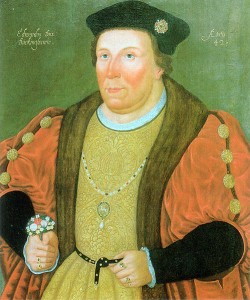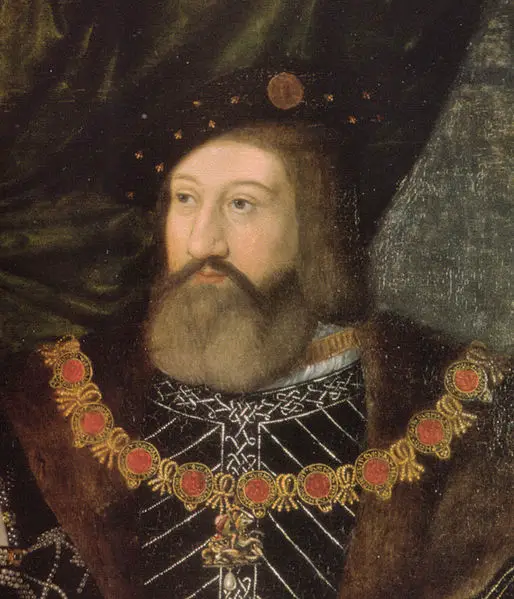
Edward Stafford
Edward Stafford, 3rd Duke of Buckingham, was one of Henry VII's and Henry VIII's main associates in court. He attended the coronation of both kings and played an important part in each of their reigns. But how he ended up in that position of favour is a fascinating story, as is his eventual demise.
Edward Stafford was born on 3 February 1478 and his parents were Henry Stafford, 2nd Duke of Buckingham, and Catherine Woodville. Catherine was the sister of Elizabeth Woodville, wife of King Edward IV. Following his father’s execution in Richard III’s reign, Edward’s mother went on to marry Jasper Tudor, Duke of Bedford and the uncle of King Henry VII.
Due to his father’s rebellion against Richard III in 1483, young Edward was hidden and moved around to different properties in and around Hertfordshire to keep him safe and out of harm's way. His father’s rebellion against the king led to him losing his honours and being executed in November 1483. In 1485, Edward was honoured by the new king, Henry VII, by being made a Knight of the Order of the Bath, and he was made a ward of Margaret Beaufort, Countess of Richmond and the king’s mother. Unfortunately, this meant that Margaret was also granted all of his lands.
It is said that Buckingham was educated in Margaret’s household. He was literate, wrote memoirs in his own hand and later went on to have a vast library. Edward's life was going to be hard, he needed to gain back respect as he was the son of a traitor and he needed to prove himself to the new king, which he managed to do. Buckingham was made a Knight of the Garter in 1495 and went on to serve in the army that was raised against the pretender Perkin Warbeck in 1497. He then gained back his lands, but was charged an extra £2,000 more a year than he should have been by Henry VII, paying £3,000 instead of just £1,000 for the rights to his lands.
Buckingham then went on to play a huge part in court activities, such as receiving foreign ambassadors and royalty and attending major ceremonies. In 1501, he welcomed Catherine of Aragon at Lambeth when she arrived to prepare for her wedding to Arthur, Prince of Wales, and he also attended their wedding, wearing a gown said to have cost £1,500. He was also the chief challenger at the wedding jousts. It was clear that Buckingham was making a come back. In 1509, following Henry VII’s death, Buckingham served as lord high constable and lord high steward at Henry VIII's coronation. He was also appointed to the new king’s privy council.
In 1513, Buckingham helped Henry VIII in his French campaign, commanding 500 men, and in 1514 he was forgiven some of the debts that had been laid against him in 1498. In 1520, Buckingham and his wife Eleanor Percy attended the Field of the Cloth of Gold, that historic summit between Henry VIII and Francis I, King of France.
Even though the duke now played an important part at court, the fact that he was one of a few remaining peers with Plantagenet blood and that he was close to his extended family did not go unnoticed by the young king. There is no evidence to support the idea that there was any open hostility between the duke and the king, but the king did not yet have a living male heir, only a daughter, and this was a worry for Henry VIII and his advisor, Thomas Wolsey. Would the country accept being ruled by a woman or would they one day look to Buckingham, whose son married Ursula Pole, daughter of Margaret Pole, Countess of Salisbury (another with Plantagenet blood) in 1519? It was not a secret that Buckingham, like quite a few others a court, hated Wolsey, due to his closeness to the king, but Buckingham had also come to the conclusion that Henry VIII did not favour those who were high born or with royal blood, hence why he kept the company of the likes of Sir Charles Brandon and Thomas Wolsey. Henry VIII, like his father, feared people who had rival claims to the throne and so saw Buckingham as a potential threat. As time went on, Buckingham was inevitably pushed out of the centre of the court and this naturally angered the duke.
This speculation and jealousy are what led to Buckingham’s downfall. In April 1521, the duke was arrested on his way to court and taken to the Tower of London. It was said that throughout the court Buckingham had made it abundantly clear that his claim to the throne was that much stronger than Henry VIII's since the king's father was from an illegitimate line. This judgement came from the fact that Buckingham thought that the Tudors lay under God's curse, hence the lack of a male heir for Henry VIII. This started an investigation which resulted in his arrest and trial. Buckingham was accused of treason for listening to prophecies about the king’s death and even plotting to kill the king. He was executed by beheading on Tower Hill on 17 May 1521 at the age of 43. It is believed that Buckingham's treason was brought about by ill-judged remarks on politics, a bad temper and the possibility of rebellion.
Written by Charlotte Donovan.
Charlotte Donovan is a 23-year-old, recent BA Hons History Graduate from the University of Hull. Her favourite time period in History is the Tudor period and she has a huge love/interest for Anne Boleyn, Henry VIII and the people of the Tudor court. Charlotte is a writer who is currently halfway through writing her first book. She lives in Hartlepool with her partner where she works at the local college as a Learning Support Assistant, she loves to read/write and also watch TV dramatisations and documentaries of her favourite time periods within history. Charlotte is also a blogger for her own site With love, Charlotte x.
Sources
- “Edward Stafford, Duke of Buckingham 1478-1521”, Luminarium.
- Edward Stafford, (3rd D. Buckingham), Tudorplace.com.
- 1521: Edward Stafford, Duke of Buckingham, ExecutedToday.com.
- Oxford Dictionary of National Biography on Edw. Stafford. (September 2004)
- “3rd Duke of Buckingham: Victim of Heresy”, TudorsDynasty.com.
- “Britannia Biographies: Edward Stafford, 3rd Duke of Buckingham”.



Edward Stafford was set up by Cardinal Wolsey who resented him after an insult. His father was a rebel and traitor, no doubt about that, but Edward was the victim of wagging tongues and a load of gossip. He was very well thought of by most people, a good friend to Queen Katherine who knew him from when she came to England as a Spanish Princess and he was the brother in law of the Duke of Norfolk. He was known as a benevolent man and was popular. His family were better connected and more Royal than Henry’s. He was executed because of jealousy on trumped up charges which Henry believed.